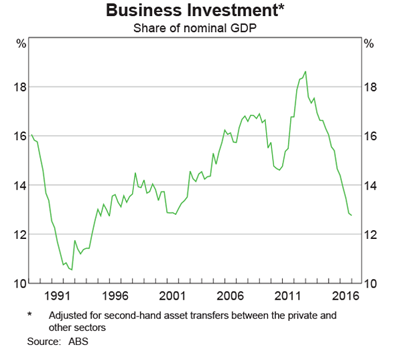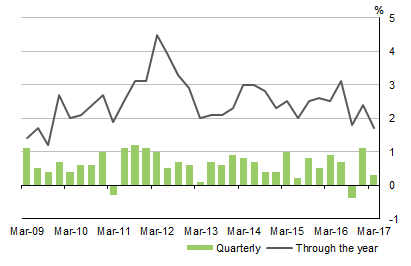Internationally, the UK elections were last week’s biggest story. May’s party had a 20 point lead in the polls when she called for snap elections. By when all the votes were counted, the Tories lost their majority, forcing her to form a coalition government.The pound broke through the 128 level versus the dollar as a result. As of this writing, things have somewhat stabilized. But the election results are at least a partial rejection of Brexit, placing May into a difficult negotiating position as she works to extract the UK from the EU.
The RBA maintained rates at 1.5% -- by far, the highest level among G7 Countries. The statement contained the following assessment of the Australian economy:
Domestically, the transition to lower levels of mining investment following the mining investment boom is almost complete. Business conditions have improved and capacity utilisation has increased. Business investment has picked up in those parts of the country not directly affected by the decline in mining investment. Year-ended GDP growth is expected to have slowed in the March quarter, reflecting the quarter-to-quarter variation in the growth figures. Looking forward, economic growth is still expected to increase gradually over the next couple of years to a little above 3 per cent.
Indicators of the labour market remain mixed. Employment growth has been stronger over recent months, although growth in total hours worked remains weak. The various forward-looking indicators point to continued growth in employment over the period ahead. Wage growth remains low and this is likely to continue for a while yet. Inflation is expected to increase gradually as the economy strengthens. Slow growth in real wages is restraining growth in household consumption.
Unlike their G7 peers, Australia didn’t contract during the global recession of 2007-2008. Instead, their raw materials complex increased production to feed China’s massive infrastructure build. But this also created an investment imbalance, with commodity based companies spending large amounts of money to satisfy Chinese demand. This chart from the RBA’s “Chart Pack” illustrates the situation:

As the economy has rebalanced, unemployment has ticked up to ~6% and the underemployment rate has also increased a bit. But this realignment has not been fatal; instead, it has simply slowed overall growth. This week’s GDP released confirmed that slowdown, with a headline growth rate of 1.7%:

While household consumption rose, fixed investment and exports were weak, indicating the Australian consumer is currently the primary source of growth. However, assuming the RBA’s analysis is correct, business investment should soon return to more normal levels.
The ECB also maintained their current rate and asset purchase policy this week. Mario Draghi offered the following analysis of the EU’s regional economy in his opening remarks:
Let me now explain our assessment in greater detail, starting with the economic analysis. Euro area real GDP increased by 0.6%, quarter on quarter, in the first quarter of 2017, after 0.5% in the last quarter of 2016. Incoming data, notably survey results, continue to point to solid, broad-based growth in the period ahead. The pass-through of our monetary policy measures has facilitated the deleveraging process and should continue to support domestic demand. In particular, the recovery in investment continues to benefit from very favourable financing conditions and improvements in corporate profitability. Employment gains, which are also benefiting from past labour market reforms, are supporting real disposable income and private consumption. Moreover, the global recovery is increasingly supporting trade and euro area exports. However, economic growth prospects continue to be dampened by a sluggish pace of implementation of structural reforms, in particular in product markets, and by remaining balance sheet adjustment needs in a number of sectors, notwithstanding ongoing improvements.
This week’s economic numbers from the EU support Draghi’s analysis. GDP increased 1.9% Y/Y, with household spending rising 1.6% and investment growing 6%. Moreover, the pace of Y/Y investment spending has increased over the last 4 quarters. Retail sales are up 2.5% Y/Y, confirming that rising employment is translating into consumer activity. And Markit’s composite index was 56.8 – the fastest pace in 6 years. The report’s new orders, employment and backlogs components all increased. The only “negative” news came from rising prices.
There were 2 UK economic releases. The Markit UK service index decreased from 55.8 to 53.8. The report indicated businesses delayed decisions due to the election. Hopefully, this number will move back to higher levels with the election over. Finally, the index of production increased .2% M/M but decreased.8% Y/Y.
Japan released the second estimate of 1Q17 GDP, which rose 1.3% Y/Y. Household spending was up .6%, residential investment rose a healthy 6.5% and non-residential investment gained 2.3. A somewhat lower yen boosted exports 3.1%. Finally, Markit’s service sector index was 53. The new business component posted a 4-year high. The backlog of orders also increased while capacity is being strained.
Once again, this week’s news illustrates that the global economy has strengthened since the first of the year. Australia continues to grow and rebalance while the EU's numbers have strengthened. The UK’s economy is a touch weaker but still expanding. And the Japanese economy is growing at a slightly stronger rate.
